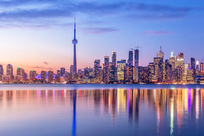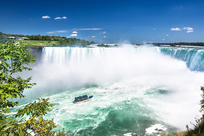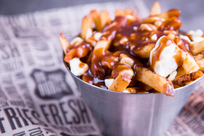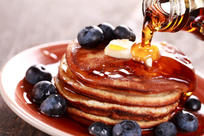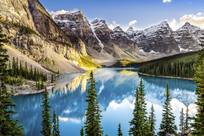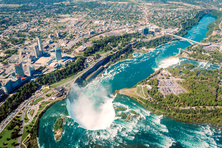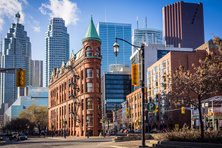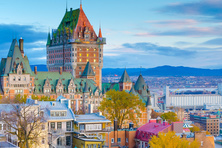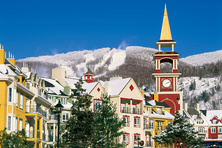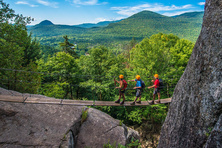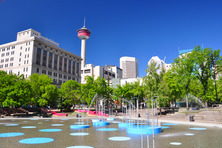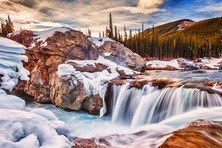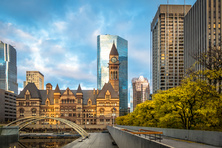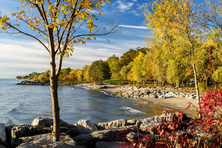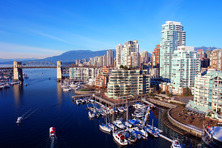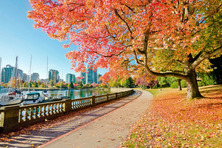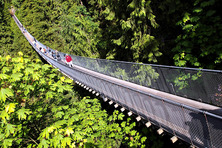Canada
- Capital:Ottawa
- Currency: Canadian dollar
- Time: UTC-3:30, UTC-8
- Languages: English, French
- Religions: Christianity (Catholicism)
- Sections: Get in Visa Customs Cuisine Money Details of interest Popular resorts
Canada is the second largest country in the world. It is located in the North America. Canada shares the land border with the United States of America and the sea border with Danish Greenland and French islands Saint Pierre and Miquelon. On the north, the country is washed by the Arctic Ocean, on the west by the Pacific Ocean and on the east by the waters of the Atlantic Ocean. The capital of Canada is Ottawa.
The climate in the country varies from region to region. On the south, it is temperate and mild, on the north the climate is subarctic. The best time for visiting Canada depends on the aim of your travel. Summer is the time for hiking, biking, sport hunting and fishing. The ski seasons begins in November and lasts until the end of May.
There are two official languages in Canada – English and French but only one out of six Canadians can speak both languages. The majority of people speak English. The Catholics and Protestants are in the majority.
In winter, dozens of ski resorts are available for the tourists. The best of them are Whistler and Mont-Tremblant. Also, the tourists can participate in numerous winter festivals and celebrations such as Montreal's festival of lights, the Winter Carnival, Ice Sculptures Competition in Quebec and sled dog racing.
Canada preserved its unspoiled wild nature. There are almost forty reserves and national parks in Canada which are a popular destination for many tourists in summer. You can enjoy the amazing nature in any Canadian province.
Canada offers many facilities for the lovers of extreme holidays. The Great Lakes is a paradise for windsurfers, the coastline along the ocean is good for diving. In the Canadian mountains, one can go climbing.
For excursions go to Winnipeg, Halifax, Yellowknife and Saint John.
Get in
By Plane
There are direct flights from Moscow and many European capitals to Toronto. The citizens of CIS countries will have to make a stop in Moscow or any other European capital to come to Canada.
By Land
There are dozens of land border stations between the USA and Canada so you can come to the country almost from any place. There are also three trains running between the USA and Canada: New York City — Montreal, New York City — Toronto and Seattle — Vancouver.
Buses run between all the large border cities of the two countries so there are many ways to travel to Canada from the USA. You can find a full list of land borders on the web site of the Canadian Border Officers.
Visa
The citizens of the majority of the European countries can stay in Canada for six months without a visa. The citizens of Bulgaria and Romania must obtain a visa as well as the citizens of Lithuania and Poland in case they do not have a biometric passport (e-passport).
The travelers from CIS countries must obtain a Canadian visa. The documents for a visa are submitted online on the web site of the Ministry of Citizenship and Immigration or in a visa center (you can submit the documents personally or send them by mail). The Embassy accepts the documents only for an immigrant visa.
Normal Canadian visa processing time is 15-27 days.
Customs
There are no restrictions concerning import and export of foreign or national currency in Canada. However, the cash in the amount of 10.000 Canadian dollars (CAD) and over must be declared. The tourists must include in their customs declaration form all the valuable goods, foods, goods derived from plants and animals imported in Canada.
The tourists can import the following goods in Canada duty-free:
- a small amount of alcohol and tobacco;
- clothes and things for personal use;
- gifts (the total sum must not exceed $300).
It is prohibited to import:
- perishables;
- some medications;
- goods for selling;
- plants and seeds.
It is not allowed to export from Canada silver coins of over $5.
Cuisine
There is no authentic Canadian cuisine and we can speak only about a mix of culinary traditions of many peoples living in the country. The dishes of English and French origin hold the main place in Canada, though today we can see a great influence of the Asian cuisine as well. The staple foods in Canada are meat and fish.
One of the most popular dishes in Canada which any tourist should try is Broshett Fillet (slices of roast fillet with button mushrooms and onion). A particular attention should be given to boiled venison and stewed rabbit with vegetables. The main dishes from poultry are roast chicken and chicken leg in a maple syrup.
The Canadians like cream soups from pumpkin, cauliflower or tomatoes and broths with croutons and noodle.
In Canada take advantage of visiting one of the numerous fish restaurants. The country is surrounded by the ocean and, of course, it can offer a great variate of fish dishes. The restaurants on the east coastline can boast of their oysters and scallops. On the Prince Edward island, the chefs excellently cook lobsters and in British Columbia, you will enjoy delicious salmon, oysters, crabs and shrimps. A hallmark dish of Nova Scotia is Solomon Grundy or pickled herring.
The most loved appetizer of the Canadians is Poutine (French fried potatoes with cheese and meat or fish sauce) and crispy potatoes fried with egg and ham.
In Canada, you should try a maple syrup which is the main culinary symbol of the country. It is used in many desserts from usual crepes to pies and cakes.
The Canadians do not have any national non-alcoholic drink. They prefer black tea and coffee.
In Canada, there some wineries but the quality of Canadian wines is moderate and for this reason, the most popular drink here is local beer.
Money
The official currency in Canada is Canadian dollar (CAD) which is equal to 100 cents. The Canadians use bank notes from 5 to 100 dollars and coins from 5 cents to 2 dollars.
The tourists can purchase the Canadian currency before their travel to the country as Canadian dollar is among major convertible world currencies. In Canada, you can exchange currency at banks, exchange offices, large hotels, airports and railway stations. The best exchange rate at banks as they do not charge a commission or charge a very small fee. In some places, you can pay with US dollars but the Canadians are very skeptical about this.
International credit cards are accepted everywhere as well as the traveler's checks Thomas Cook and American Express.
In Canada, there is a system which is a local version of tax-free. The tourists can refund 7-15% of their purchase (depending on the province). The tourists can refund the money provided that they their purchase will be sent to their home address outside Canada. You can also refund VAT for living in a hotel and paying for the excursion programs.
Details of interest
Sightseeing in Canada
In Canada, there are 17 sites inscribed on the UNESCO World Heritage List:
- The archaeological site L’Anse aux Meadows in the province of Newfoundland and Labrador. As archaeologists say, this was the Viking settlement at the end of the 11th century.
- Wood Buffalo National Park in the province of Alberta and on the Northwest Territories of Canada. This is the largest national park in the country with the largest herd of wild buffalos on the continent. For many tourists, this park is the main destination.
- The Canadian Rocky Mountain Parks in the province of Alberta and British Columbia. This is a complex of four national parks and three provincial parks. UNESCO described the complex as an “amazing highland landscape”.
- The Old Quebec is a historical city center and the only city in the North America which preserved its fortifications built in the 18th-19th centuries.
- The historical city of Lunenberg in the province of Nova Scotia is an excellent example of a colonial British city in the North America.
The tourists can also visit the UNESCO candidate sites such as:
- Reserves and national parks of the protected area of Pimachiowin Aki in Ontario and Manitoba. This is a big biosphere reserve with beautiful nature and numerous historical monuments of the pre-Columbian era.
- Klondike National Historic Site in the province of Yukon is the place of the notorious Gold Rush.
- Quttinirpaaq National Park in the province of Nunavut is a reserve in the Far North region of the country.
Do not miss a chance to visit other sights and places in Canada which are not under UNESCO protection but still of a great touristic interest:
- The Niagara Falls.
- The CN Tower in Toronto.
- The Notre-Dame Basilica in Montreal.
- The West Edmonton Mall.
- The park Hopewell Rocks in New Brunswick.
- The Interprovincial Park Cypress Hills in Alberta and Saskatchewan.
Canadian Souvenirs
In Canada, the tourists usually buy:
- maple syrup;
- ice wine;
- Indian amulet Dreamcatcher;
- figurines of Canadian policemen;
- figurines of animals.







